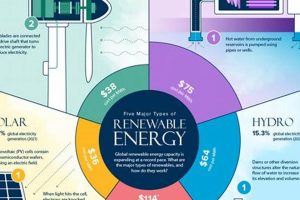
A visual representation depicting the proportional contributions and trends of various naturally replenishing energy technologies such as solar, wind, hydro, geothermal, and biomass constitutes a significant tool for understanding the evolving energy... Read more »

The creation of electrical power using naturally replenishing resources constitutes a vital component of modern energy infrastructure. Solar, wind, hydro, geothermal, and biomass exemplify the diverse range of inputs used in this... Read more »

Energy sources that replenish naturally and sustainably over time are considered inexhaustible. These resources stand in contrast to finite options that deplete with use. Common examples include solar power, harnessed from the... Read more »

Determining the superior option among power generation methods that naturally replenish is complex, involving multiple metrics beyond raw energy conversion. Assessing effectiveness requires considering factors such as resource availability, technological maturity, geographic... Read more »

The advantages derived from utilizing naturally replenishing power generators are numerous and span various sectors. These advantages encompass environmental protection, economic growth, and enhanced energy security. An example is solar power, which,... Read more »

Biodiesel represents a fuel derived from renewable biomass sources, such as vegetable oils, animal fats, or recycled greases. These feedstocks undergo a chemical process, typically transesterification, to produce a fuel that can... Read more »

Harnessing power from naturally replenishing resources offers a sustainable alternative to fossil fuels. These resources, unlike finite reserves, are continuously renewed by natural processes, ensuring long-term availability and minimizing environmental impact. Examples... Read more »

Harnessing energy from naturally replenishing resources presents a spectrum of favorable outcomes. These encompass environmental protection, economic growth, and enhanced energy security. Examples include reduced greenhouse gas emissions compared to fossil fuels,... Read more »

The central question regarding hydrogen’s role in sustainable power systems revolves around its origin. While hydrogen itself is the most abundant element in the universe, its availability as a usable energy carrier... Read more »

Power generation methods relying on naturally replenishing resources are evolving rapidly. These upcoming technologies harness energy from solar, wind, geothermal, hydro, and biomass in innovative ways, moving beyond traditional implementations. For example,... Read more »


